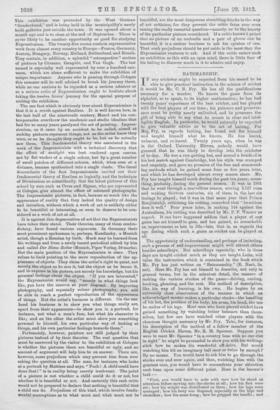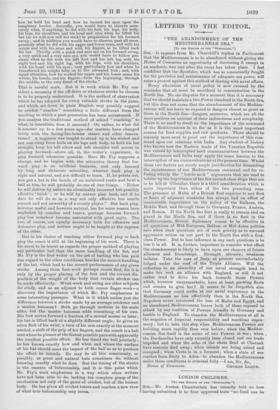BATSMANSHIP.
IF any cricketer might be expected from his record to be able to give practical instruction in the science of cricket it would be Mr. 0. B. Fry. He has all the qualifications necessary for a teacher. He knows the game from its alphabet, so to speak, to its higher mathematics ; be has had
twenty years' experience of the best cricket, and has played with the best players of our time ; his patience and persever-
ance must be pretty nearly unlimited, and he possesses the gift of being able to say what he means in clear and intel- ligible English. In particular, he would naturally be expected to give valuable advice as to the art of batting. For Mr Fry, as regards batting, has found out for himself
and taught himself what he knows. He has learnt,
unlearnt, and re-learnt. Twenty years ago, when he WAS in the Oxford University Eleven, nobody would have guessed that he was likely to develop into the cricketer of to-day. He was a run-getting bat, and scored a hundred in
his last match against Cambridge, but his style was cramped and ungainly, and gave no promise of the free and command- ing methods which he gained some four or five years later,
and which he has developed almost every season since. Air. Fry has taught himself much during the past ten years; some- thing, probably, during the present season. It was in 1901 that he went through a marvellous season, scoring 3,147 runs
and making thirteen centuries, six of them iu the last six innings he played; but it was in that same year that Prince Ranjitsinhji, criticising his cutting, remarked that "be seldom does it well." Four years later, in making 144 against the Australians, his cutting was described by Mr. P. F. Warner as superb. It can have happened seldom that a player of any game has set himself to gain, and has gained, so remarkable an improvement so late in life—late, that is, as regards the age during which such a game as cricket can be played at
The opportunity of understanding, and perhaps of imitating, such a process of self-improvement might well attract others besides schoolboys. But schoolboys especially, who in these days are taught cricket much as they are taught Latin, will value the instruction which is contained in the book which Mr. Fry has just written on " Batsmanship " (E. Nash, es. net). Here Mr. Fry has set himself to describe, not only in general terms, but in the minutest detail, the manner of making the various strokes of the game—driving, cutting, booking, glancing, and the rest. His method of description, like his way of learning, is his own. He begins by an extremely close observation of the manner in which an acknowledged master makes a particular stroke—the handling o his bat, the position of his body, his arms, his head, the use he makes of his legs. Most men who have played cricket have gained something by watching better batsmen than them- selves, but few can have watched other players with the closeness thought necessary by Mr. Fry. Take, for instance, his description of the method of a fellow member of the English Cricket Eleven, Mr. R. H. Spooner. Suppose you were to meet Mr. Spooner "in a country lane with no one else in sight" he might be persuaded to show you with his walking. stick how he makes his wonderful off-drive. But would watching him hit an imaginary ball once or twice be enough? By no means. You would have to ask him to go through the stroke over and over again, and then, watching him with the greatest care, you would have to concentrate your attention each time upon some different point. Here is the learner's task :— "First, you would have to note with care how he stood at attention before moving into the stroke at all ; how his feet were set ; how his weight was distributed on them ; how his logs were arranged; how his body was disposed, especially at the hips and shoulders; how his arms hung ; how he gripped the handle ; and how he held his head and how he turnod his eyes upon the imaginary bowler. Secondly, you would have to observe accu- rately what, if anything, he did with his feet, his legs, his body, his hips, his shoulders, and his head and eyes when he lifted his bat (as v.-o will now call his stick) in preparation for his forward swing ; and in addition you would have to observe, past an error, precisely what he did with his upper and lower arms, and with his wrists and with his arms and with his fingers, as he lifted back his bat. Thirdly, with a quick and sure eye on his forward swing, a very quick and a very sure eye, you would have to follow pre- cisely what he did with his left foot and his left leg, with his right foot and his right leg, with his hips, with his shoulders, with his head, with his eyes ; very particularly how and when he transferred his weight fully on to the advanced foot ; and, with equal attention, how he worked his upper and his lower arms, his wrists, his hands, and his fingers—from the beginning, through the middle, to the very finish of the stroke."
That is careful work. But it is work which Mr. Fry con- siders a necessity if the off-drive or whatever stroke he chooses
is to be properly understood. It is the method of observation which he has adopted for every valliable stroke in the game, and which, set down in plain English, may possibly suggest to cricket " coaches " something a little different from the teaching to which a past generation has been accustomed. If you analyse the traditional method of school "coaching," to what, in essentials, does it amount P Or, rather, to what did it amount up to a few years ago—for matters have changed lately with the facing-the-bowler stance and other innova- tions P A beginner was taught to stand up to his wicket and not run away from balls on his legs and body, to hold his bat straight, keep his left elbow and left shoulder well across in playing forward—above all, in the writer's experience, to play forward whenever possible. Here Mr. Fry suggests a change, and he begins with the attractive theory that for- ward play is an artificial business, and only learned by long and elaborate schooling, whereas back play is right and natural, and not diffioult to learn. If, he points out, you put a bat in the hands of an untutored rustic and bowl a ball at him, he will probably do one of two things. "Either he will deliver by nature an abominably incorrect but possibly effective ' hoick '; or he will by nature play back, and if he does he will do so in a way not only effective but nearly correct and not unworthy of a county player." But back play, however useful and however natural, has for some reason been neglected by coaches and tutors, perhaps because forward play has somehow become associated with good style. The two, of course, are equally necessary both for offensive and defensive play, and neither ought to be taught at the expense
of the other.
But in his choice of teaching 'either forward play or back play the coach is still at the beginning of his work. There is far more to be learnt as regards the proper method of playing any particular ball than the mere handling of the bat, and Mr. Fry is the first writer on the art of batting who has paid due regard to the other conditions, besides the Correct handling of the bat, which lead to the correct performance of any given stroke. Among them foot-work perhaps comes first, for it is only by the proper placing of the feet and the correct dis- position of the weight of the body that certain strokes can be made effectively. Wrist-work and swing are other subjects for study, and as an adjunct to both comes finger-work—a discovery the importance of which Mr. Fry emphasizes in some interesting passages. What is it which makes just the difference between a stroke made by an average cricketer and a master batsman P Both go through motions in the main alike, but the master batsman adds something of his own. His foot moves forward a fraction of a second sooner or later ; his bat is lifted back at a slightly different angle ; he gives an extra flick of his wrist, a turn of his arm exactly at the moment needed, a shift of the grip of his fingers, and the result is a ball sent where be pleases at the fastest possible pace with apparently the smallest possible effort. He has timed the ball precisely ; he has known exactly how and when and where the surface of his bat should meet the impact of the ball so as to produce the effect he intends. He may do all this consciously, or possibly, as great and natural bats sometimes do, without knowing exactly what he does. But the timing of the stroke is the essence of batemanship, and it is this point which Mr. Fry's work emphasises in a way which other writers have not been able to do, lacking his complete grasp of the mechanism not only of the game of crioket, but of the human body. He has given all cricket tutors and coaches anew view of what true batsmanship may mean,























































 Previous page
Previous page